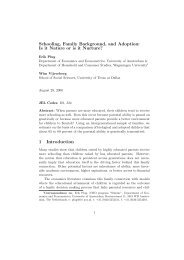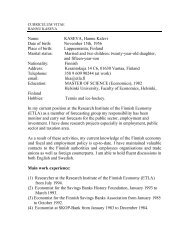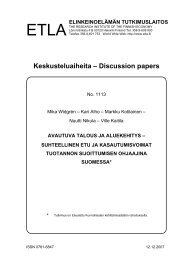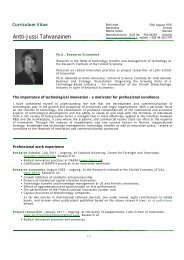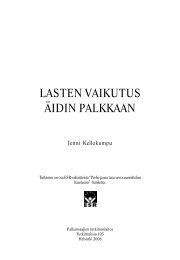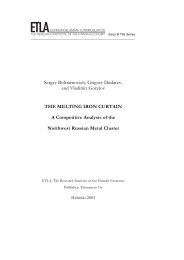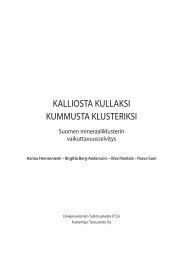Download PDF - Etla
Download PDF - Etla
Download PDF - Etla
Create successful ePaper yourself
Turn your PDF publications into a flip-book with our unique Google optimized e-Paper software.
6<br />
2.3. THE CROSS‐FUNCTIONAL DEPENDENCIES VIEW<br />
This approach examines the implications of, say, manufacturing locations on decisions regarding<br />
R&D location. Studies examining the internationalization paths of manufacturing<br />
and R&D often focus on cross‐functional interdependence. Both economists and organization<br />
scientists have used this approach, although organization‐level studies tend to dominate.<br />
Organizational factors in particular cause R&D and manufacturing to be interdependent: decision<br />
regarding one cannot be made without considering the other. These functional interdependencies<br />
are often either of sequential or reciprocal variety, to use Thompson’s (1967) interdependence<br />
typology. In the former one function is dependent on the other for information,<br />
materials, or technology, while in the latter the two are mutually co‐dependent and joint<br />
problem‐solving is required. Now, physical co‐location of the two functions is one way to<br />
manage reciprocal interdependencies in particular, although there are other viable and perhaps<br />
more ”light‐weight” alternatives for coordination as well. Activities such as new product<br />
development (NPD) and the associated new product introduction (NPI) are prime examples<br />
of situations where reciprocal interdependencies likely exist and where effective crossfunctional<br />
coordination is required (Adler, 1995). These will be further examined in this paper<br />
as a special case.<br />
2.4. TENSIONS AND TRADEOFFS BETWEEN THE THREE VIEWS<br />
What makes the study of determinants of (co‐)location decisions particularly interesting and<br />
relevant is the proposition that there are tradeoffs or tensions between the three views. What<br />
I mean by tension here is not to imply that the views are conflicting views. They aren’t in conflict<br />
with one another per se, because they address different aspects of the same phenomenon.<br />
But they may lead to different kinds of predictions and managerial prescriptions regarding<br />
co‐location. For instance, if the management team wanted to optimize on external<br />
drivers, it might opt not to co‐locate R&D and manufacturing. Functional interdependencies,<br />
in turn, might imply co‐location.<br />
This potential tension has been identified, although empirical treatments of the issue appear<br />
scarce. Specifically, we have some—at least indirect—empirical evidence that tensions may<br />
indeed exist. Audretsch and Feldman (1996) provide empirical evidence of this at the industry<br />
level by observing that in the U.S. the factors explaining the dispersion of R&D activities<br />
are quite different from the factors that explain dispersion of manufacturing activities. Mariani<br />
(2002, p. 31), in turn, has explicitly argued that ”in developing innovations a tradeoff exists<br />
between the benefits of spreading research close to production, and the advantages of<br />
concentrating it in the areas with technological external economies”. In a similar vein, Blanc<br />
and Sierra (1999, p. 187) argue that ”the multinational firmʹs external organization should not<br />
be constituted to the detriment of its organizational coherence; it should, on the contrary, be<br />
completed by the implementation of relations of proximity internal to the firm.” Whether<br />
complementarity between the internal and external drivers and organization is possible is,<br />
however, debatable; it seems that companies that prefer co‐locating their R&D and manufacturing<br />
operations to manage functional interdependencies may indeed be forced to make a<br />
tradeoff in that they are simultaneously giving up potential benefits of external economies<br />
such as R&D spillovers. But these should be considered working hypotheses at this point.



